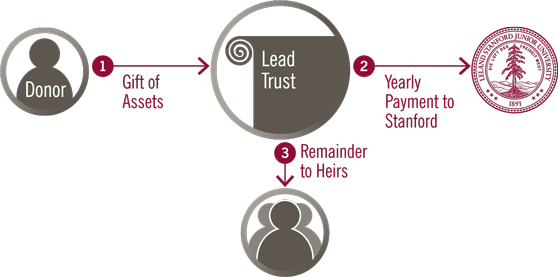Charitable Lead Trusts
By establishing a charitable lead annuity trust at Stanford, you can make significant annual gifts to Stanford and reduce the tax burden on your heirs.
/f/78141/5534x3689/a2b8754159/img_1702.jpg)
How it works
You establish a charitable lead annuity trust by irrevocably transferring assets to a trustee, who makes an annual distribution from the trust to Stanford for a set number of years. When the trust terminates, the assets in the trust are distributed to your heirs or others that you designate. Stanford can serve as trustee of charitable lead trusts.
On the date you establish the trust, the future gift to your heirs will be valued for gift and estate tax purposes at its “present value.” If the trust is created when interest rates are low and the trust’s investments perform better than expected, there may be additional assets in the trust that will pass to your heirs free of estate and gift taxes.
Benefits
Pass assets to your heirs at low (or no) estate and gift taxes.
Make annual gifts to Stanford.
This might interest you if...
You want to make a gift to Stanford and you:
Have a large estate that would be subject to gift and estate tax.
Want to pass assets to children or other heirs at a low gift or estate tax cost.
Own a valuable asset that you want to keep in the family, you expect will appreciate in value, and that currently produces income.
Own securities or cash that you would want invested for growth so that wealth can be passed on to your children or other heirs in the future.
Would like to have a charitable lead trust managed by Stanford.
Assets used
Usually cash or assets that have a likelihood of significant appreciation in the future.
Contact us
If you are interested in learning more about creating a Stanford charitable lead trust, please contact us. We would be happy to provide you with information about how a charitable lead trust would work for you based on your circumstances.
Those considering a planned gift should consult their own legal and tax advisors. The staff in the Office of Planned Giving are happy to speak with advisors as well.
Charitable lead annuity trust
Richard Mita is in high tax brackets for income, gift, and estate tax, and he has used up all of his gift tax exemption for lifetime gifts.
If he makes an additional outright gift now to his children, he will incur a substantial gift tax. If he defers making gifts to them, and the assets meanwhile appreciate in value—as he expects they will—the eventual gift tax or estate tax could be even higher, because the tax will be based upon the appreciated value of the assets at the time of the gift.
He also wants to support Stanford. Instead of giving the assets directly to his children, in August 2012, Richard funds a charitable lead annuity trust with assets currently valued at $1 million. The trust will pay a fixed 6 percent annuity ($60,000) to Stanford for 20 years, and then the remaining assets will be distributed to his children. Because the IRS assumes that the trust investment performance will be only 1 percent over time, the IRS predicts that there will be nothing left in the trust at the end of 20 years, so the value of the gift to his children would be calculated to be zero. On the other hand, if the trust investments grow more than 1 percent over time, there will be assets left in the trust, and those assets will pass free of income and estate tax to his heirs.
